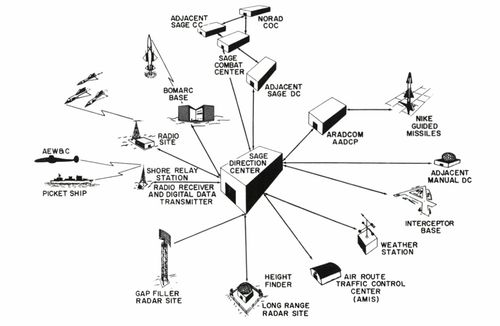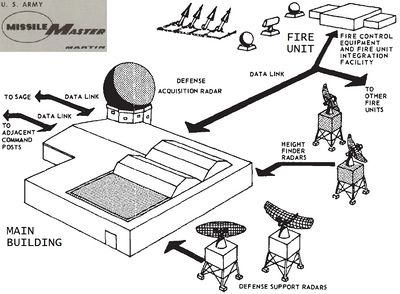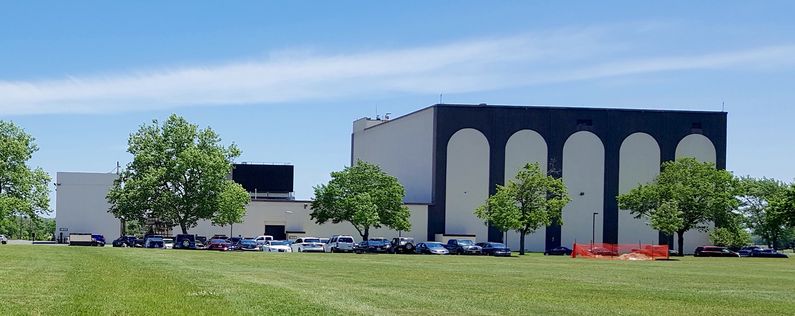McGuire SAGE Direction Center DC-01
|
McGuire SAGE Direction Center DC-01 (1958-1968) - A Cold War SAGE System Direction Center first established in 1957 on McGuire Air Force Base in Burlington County, New Jersey. Named McGuire SAGE Direction Center after the location. Assigned a Sage ID of DC-01. Deactivated as a SAGE Direction Center in 1968.
History of McGuire SAGE Direction CenterEstablished in 1957 and became operational on 1 Jul 1958 as McGuire SAGE Direction Center DC-01.  Direction center equipment included the duplex FSQ-7 computer system and associated communication equipment. The FSQ-7 computer system assembled digitized inputs from USAF Radar Sites to provide tracking and identification of all aircraft within their sector of responsibility. The digitized radar inputs came from USAF Radar Sites, airborne radar pickets, Texas Towers, Gap Filler Radar Sites and other radar sources. The total picture of aircraft in the sector was assembled and any unknown aircraft were checked out and hostile aircraft were engaged by USAF fighter aircraft, Bomarc missiles or NIKE missiles. The primary defense was against the Soviet threat of a mass nuclear bomber attack on the US. The system evolved before the advent of ICBMs and provided no missile defense against them. The computer technology was first generation vacuum tube equipment and required significant power and air conditioning. The physical plant of the direction center was enclosed in a large multi-story concrete blockhouse that housed the duplex FSQ-7 computer, communications equipment, a powerhouse, air conditioning systems and operational areas. The operational areas included radar mapping, air surveillance, identification, communications and weapons direction. The enormous cost of the radar sites, direction centers, personnel, and training caused an immediate reevaluation and almost as quickly as they were built some facilities were closed. The first mass closures began in the 1960s when many radar sites and virtually all the gap filler sites were closed. The first round of direction center closures came in 1963 when six were closed, a second round in 1966 and a third in 1969 that closed a total of 17 out of 23. The remaining six direction centers became SAGE Regional Control Centers (RCCs) still using the massive FSQ-7 vacuum tube computers. As the direction centers and radar sites closed the remaining sites were realigned into ever-increasing sectors. A new Joint Surveillance System (JSS) evolved as a partnership between the Air Force and the FAA to provide nationwide radar coverage. When completed in 1983 it consisted of only forty-six radar sites feeding into four new Region Operation Control Centers (ROCCs) with FYQ-93 computer systems. With the activation of the four U.S. ROCCs and the two Canadian ROCCs, the last seven of the SAGE direction centers were deactivated and this signaled the end of the SAGE system. Of the remaining forty-six radar sites, thirty-one had FAA-operated search radars and USAF operated height finders. Five sites just had FAA search radars and only ten sites were operated by the Military. With the deployment of forty FAA ARSR-4 3D radar sets in the 1990s, the earlier military and FAA radars were replaced. The Canadians closed their underground SAGE Direction Center and created two ROCCs (CAN-East and CAN-West) using the FYQ-93 computers in the underground facility.
The McGuire SAGE Direction Center DC-01 was deactivated 31 Dec 1967.
BOMARC/SAGE Interface
NIKE/SAGE Interface The U.S. Army Nike Missile System was developed in the 1950s to replace radar guided anti-aircraft gun batteries deployed around critical manufacturing and population centers. The system developed by the U.S. Army was the Nike AJAX missile with a range of about 26 miles and a ceiling of about 55,000 feet. The Nike AJAX missile system was deployed between 1954 and 1963. The Air Force SAGE System served as the primary defense system while the NIKE Ajax sites were in place to take out any enemy aircraft that were not intercepted by the Air Force. The NIKE sites in the United States were organized into NIKE Defense Areas that usually consisted of an AADCP command post, a long range radar site, and a number of launch site/control site pairs. Many times the command post and the long range radar site were co-located and the long range radar site could be a U.S. Army or U.S. Air Force facility. The command posts evolved into automated operations using a Missile Master FSG-1 system, a BIRDIE GSG-5 system or the Missile Mentor TSQ-51 system. The SAGE System direction centers and the backup BUIC System could directly send track data and assignments to Nike Missile Master AADCPs. At the SAGE Direction Centers the Army air defense artillery director (ADAD) consoles and a field grade Army ADA battle staff officer coordinates AADCPs. In 1958 the U.S. Army began to deploy the second generation NIKE Hercules missile with a range of 90+ miles and a 100,000 foot ceiling. The Hercules could carry conventional and nuclear warheads. As the NIKE Hercules was deployed the old AJAX sites were either closed or modified for the Hercules missiles. The last stateside Nike AJAX site was deactivated in 1963. The NIKE Hercules System was deactivated in 1974.
The McGuire SAGE Direction Center DC-01 was connected to the New York Army Air Defense Command Post (AADCP) designated NY-55DC at Highlands Air Force Station, New Jersey and the Philadelphia Army Air Defense Command Post (AADCP) designated PH-64DC at the Pedricktown Army Installation, Pennsylvania. The AADCPs directed the Nike batteries in the New York Defense Area and batteries in the Philadelphia area. Current StatusSage Direction Center blockhouse repurposed on McGuire Air Force Base in Burlington County, New Jersey.
See Also: Sources:
Links:
Visited: 9 Jun 2016 | ||||||||||||||||||||||||||||||||||||||||||||||||||||||||||||||||||||||||||||||||||||||||||||||||||||||||||||||||||||||||||||||||||||||||||||||||||||
